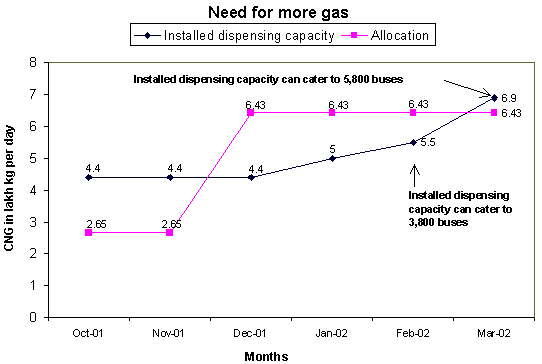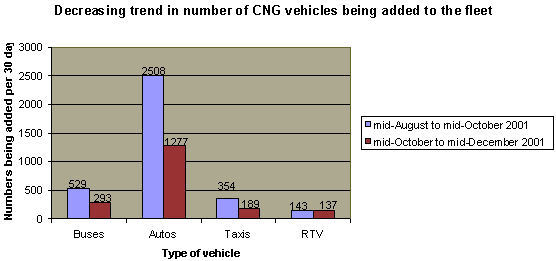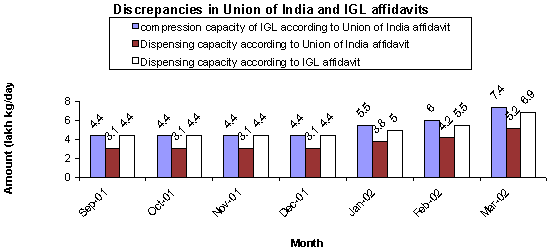|
| Plan for phase in of buses |
How many buses can be supplied gas currently?
As per IGL's affadavit the status as date is:
· CNG allocated to the transport sector by MoPNG is 6.4 lakh kg per
day.
· Total dispensing capacity of IGL is 5.5 lakh kg per day in February
2002.
· The total gas needed by all the vehicles on the road in
January-February is 5.49 lakh kg per day. This means as of date, IGL can just about supply
enough gas to all the vehicles on the road. (See table 1: CNG needed per day to meet the
full demand).
· The total CNG buses on road are 3800. Thus, as of February 2002, if
all vehicles were to come for refills everyday not a single bus can be added to the fleet.
|
Table 1: CNG needed per day to meet the full demand (February 2002) |
Type of Vehicle
|
Total vehicles actual and projected for Feb 2002 |
CNG needed per day per
vehicle(Kg)
|
Total amount of CNG needed per day on the assumption
that all vehicles come for refill everyday(lakh kg per day)
|
| Buses |
3,800 |
70 |
2.66 |
| RTVs |
1,750 |
18 |
0.32 |
| Cars |
10,350 |
4 |
0.41 |
| Taxis |
4,000 |
8 |
0.32 |
| Autos |
35,500 |
5 |
1.78 |
| Total |
58,500 |
|
5.49 |
|
Source: Indraprastha Gas Limited |
· By March end, if IGL increases its dispensing capacity to 6.9
lakh kg per day as it states in its affidavit and also has the 55 compressors working, it
can supply gas to an additional 2000 buses and all the other vehicles on road today. |
Table 2: How many buses can be added to the fleet by March 2002
| Type of Vehicle |
Total vehicles projected for March 2002 |
CNG needed per day per
vehicle(Kg) |
Total amount of CNG needed per day(lakh
kg) |
| Buses |
5,800** |
70 |
4.06 |
| RTVs |
1,750 |
18 |
0.32 |
| Cars |
10,350 |
4 |
0.41 |
| Taxis |
4,000 |
8 |
0.32 |
| Autos |
35,500 |
5 |
1.78 |
| Total |
61,400 |
|
6.89 |
|
Source: Indraprastha Gas Limited
Note: ** Projected figures for buses. |
MoPNG has allocated only 6.4 lakh kg of gas
for transport while IGL will be in a position to dispense 6.9 lakh kg of gas in March
2002. This means allocation is falling short by 0.5 lakh kg per day.
Thus in March 2002, not only will dispensing
capacity fall short of the demand if the Supreme court order of 10,000 buses has to be
implemented, the allocation to IGL will have to be increased to 7 lakh kg per day to cater
to 10,000 buses or 10 lakh kg per day to meet the needs to all vehicles on road today.
This is assuming that there will be no further growth in CNG vehicles in other categories.
|
|
Delhi government and the Union government claim
in their affidavits that only 200 buses can be added to the fleet every month as per gas
dispensing capacity. According to our calculation IGL can cater to 5800 buses by March
2002.
After March 2002, IGL cannot cater to any further growth unless there is new allocation of
gas by the Union government. |
 |
It is clear from the above, that all parties have shown a
complete lack of seriousness in implementing the court order; |
The Union government has failed to allocate
enough gas to meet the needs of vehicles. The MoPNG has not even provided till date for
the needs of the 10,000 buses, which the court ordered in mid-1998.
The Delhi government has done little to
expedite the clearance of the 12-inch pipeline from Dhaula Kuan to G.T. Karnal road,
needed to set up mother and online stations in west Delhi and increase the dispensing
capacity;
The infrastructure provided by IGL is only
now beginning to outpace the demand for the gas. Only in March 2002, will IGL have excess
dispensing capacity and could cater to 2000 additional buses. But after March, its
expansion will depend on the additional allocation of gas by the Union government and the
clearance for the pipeline by the Delhi government
|
|
Therefore, all these agencies have worked to ensure that the
supply position remains tight and provides them with an easy excuse to allow the diesel
buses to ply.
How will the demand of other category of vehicles be
met after March?
By end March 2002, there will be enough gas
(allocation and supply) to meet the needs of 5,800 buses along with the fleet of other CNG
vehicles on the roads today. This assumes that there will be little or no increase in the
CNG fleet (except buses) based on the experience of the last few months. In January, for
instance, no new CNG vehicles have been registered.
This is because the government (through IGL) has made it clear that it will not supply gas
to private vehicles even though this would have lead to major improvements in air quality.
It has also clarified that the court order for converting to CNG is not applicable to
autos and taxis.
This is already leading to a marked decrease in CNG vehicles. According to data provided
to IGL by the State Transport Authority the number of CNG vehicles coming to the roads is
clearly declining. While 529 CNG buses were added to the fleet during the period August to
October 2001, only 293 CNG buses were added to the fleet during the period mid-October to
mid-December 2001. Similar trend has been observed in the case of other vehicles as well.
|
Graph 2: Negative growth rate of CNG vehicles
 |
· During August to October 2001, 529 CNG
buses were added to the fleet, which decreased to 293 during the period October-December
2001, a decrease of more than 44 per cent.
· Autos show a drop of as much as 49 per cent and taxis almost 47 per
cent.
Is the problem dispensing capacity (as the Union
government claims) or something else?
There is a discrepancy in the estimates given
by IGL in its affidavit and given by the Union government in its affidavit, with regards
the compression and dispensing capacity available in the city.
The Union government affidavit puts the blame on the inadequate dispensing capacity of the
IGL as the root cause of the problem. It states that IGL is in a position to dispense only
70 per cent of their compression capacity. According to the Union government by Feburary
2002, IGL can compress 6 lakh kg of natural gas per day but can dispense only 4.2 lakh kg
of this compressed gas.
But IGL disagrees. According to IGL compression capacity is equal to dispensing capacity
so far. IGL can compress and dispense 5.5 lakh kg per day in February 2002.
Graph 3: Discrepancy in MoPNG and IGL affidavits as regards the
dispensing capacity of IGL
MoPNG claims that dispensing capacity of IGL is 70 per cent of the total
compression capacity. But IGL estimates show that their dispensing capacity matches their
compression capacity.

|
Source: IGL and Union of India affidavits
IGL has estimated the total amount of CNG needed per day in February which
shows that to meet the demand for 6,900 buses, 1750 RTV, 10,350 cars, 4000 taxis, 35,500
autos, the total CNG required per day would be 7.66 lakh kg per day. But based on their
actual observed sales everyday at the dispensing stations they have found that about 70
per cent of the vehicles come for refill everyday and not 100 per cent. This means their
actual per day sales is 70 per cent of the dispensing capacity, which is 5.33 lakh kg per
day. On this basis IGL estimates that the total demand per day in February 2002 would be
5.33 lakh kg per day.
This has been misinterpreted by the Union government to say that IGL can dispense only 70
per cent of the compression capacity. |
|
| The complete information |
|
|
|
CONTACT US
AIR POLLUTION CONTROL UNIT
CENTRE FOR SCIENCE AND ENVIRONMENT
41, TUGHLAKABAD INSTITUTIONAL AREA
NEW DELHI-110062
Tel: +91 (011)-29955124, 29955125, 29956394, 29956401, 29956399
EXTN. 222
Fax: +91 (011) 29955879
E-MAIL: webadmin@cseindia.org |
|